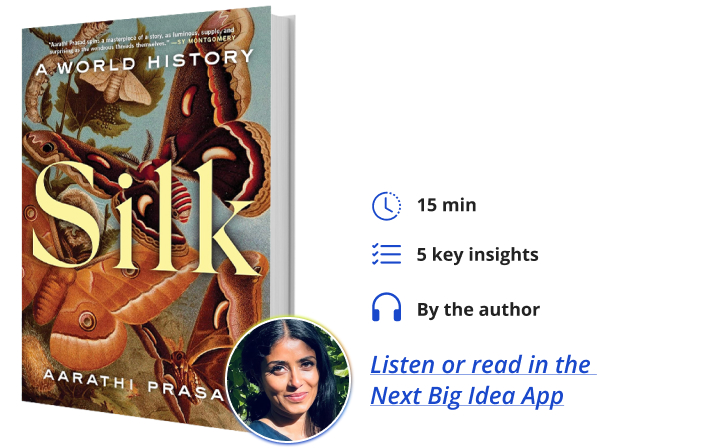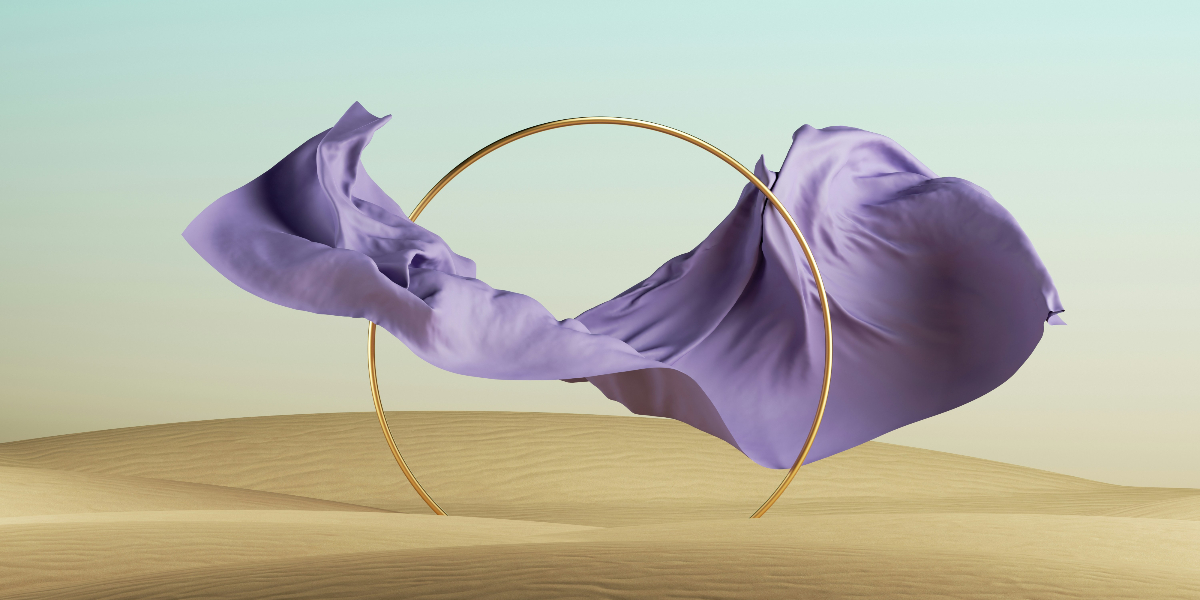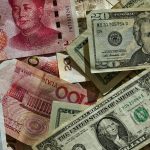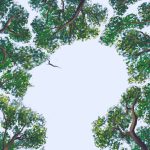Aarathi Prasad is an author, broadcaster, and researcher. She was educated in the West Indies and the UK. After completing a PhD in molecular genetics from Imperial College London, she later trained in bioarchaeology. She is an Honorary Research Fellow at University College London’s Department of Genetics, Evolution and Environment, and part of an international team excavating and analyzing ancient DNA from funerary sites in Spain, Rome, and Pompeii.
Below, Aarathi shares five key insights from her new book, Silk: A World History. Listen to the audio version—read by Aarathi herself—in the Next Big Idea App.

1. The origins and ancient routes of silk.
Chinese silk has always been the most well-known, and we often only think of the celebrated cloth that comes from a moth known as the Bombyx mori. This B. mori is a small, pale moth that hasn’t existed for that long in the greater scheme of things. Although genetic studies have been unable to validate exactly how old it is, it’s likely to be some 4,000 to 5000 years old.
It began life by being bred from a wild ancestor, Bombyx mandarina Moore, a rapidly flying, well-camouflaged insect—also known as a pest to farmers, but it produced a lovely, fine, white silk. All those millennia ago, neolithic farmers in the East of China bred it until it developed specific valuable traits. In doing so, they created the world’s only truly domesticated insect. That also meant that this little moth has also become very boring. It lost its natural camouflage, cannot fly, is born blind, and is completely dependent on humans to feed and to mate.
The moths develop through a method called complete metamorphosis, which means the young larva look nothing like their moth adult forms. First, the wriggling caterpillars hatch out of tiny eggs. Over some weeks, they eat copious amounts of white mulberry leaves, their favorite food, until they become juicy caterpillars about three inches long.
Then, they stop. They stop eating and stop moving. That is a very precarious thing for a juicy little insect to do. At this point, they excrete liquid silk, made in glands along their bodies, that emerges via their salivary gland. When the silk liquid hits the air, it solidifies into a thread. In total, each caterpillar makes a continuous thread of around half a mile in length. This thread is 1,000 times finer than a human hair and yet possesses incredible tensile strength.
2. Moths don’t make the only silk.
The 18th-century scientist René-Antoine Ferchault de Réaumur once wrote, “Nature does not limit itself to a few examples, even of its most singular productions.” Silk was one of those most singular productions, and Reaumur knew that well. He was a mathematician turned entomologist and was intrigued by all of nature.
It had become a particular fascination for scientists of his time to study the silk of spiders. In 1710, he was commissioned by the Paris Academy of Sciences to do just that. Spider silk was (and remains) the holy grail of silks by virtue of its incredible strength and elasticity. It is said that if a spider were the size of a human, its web would be strong enough to stop a jetliner in its path. Spiders do not, with good reason, like to cooperate with humans who want their silk. This has been an eternal problem. In the last few years, Professor Randy Lewis’s lab at Utah State University sought ways around that, such as modifying bacteria, yeast, silk moths, and even goats to produce a kind of spider silk.
“It is said that if a spider were the size of a human, its web would be strong enough to stop a jetliner in its path.”
But Réaumur was also deep into the study of the anatomy of another animal, known as the Pinna nobilis. This is a Mediterranean mollusk shaped like a fan, growing up to just over three feet tall. It narrows to a sharp point at its base and fans out into a semi-oval above, like a gigantic quill pen. At its sharp-pointed base is a shock of long, fine filaments that look like locks of human hair but up to three times finer. The filaments come in shades of bronze or copper, golden yellow to brown, and olive green to black. These threads also have an incredible property: they are self-healing. Known as sea silk, it was woven, likely since very ancient times, to make clothing. In the oldest remaining examples, the striking colors of their threads remain completely intact.
3. Silk, in all its wonderful varieties, is a global story.
More broadly, human innovation is global. We live in a world with imbalanced ideas of where knowledge is created, by whom, what innovation is, and who innovates. Naturally, people everywhere had watched and studied their world in different ways and engaged with it to their benefit. Where there was an animal that made silk, those threads were used in interesting ways. It is not always easy to find, in equal measure, the voices of all people so that we might understand the history of their knowledge of, and of their relationship, with silk. We have European colonial writings on their discoveries and the correspondence of Western men of science that allude to local peoples and their practices at the time at which those records were made. There are few records from the local—or indeed, women’s—perspective left to piece together. Many indigenous women and men who informed the study of silk-producing animals in various ways remain nameless.
Throughout the African continent, many animals produced silk, from which people produced prestigious fabrics. It was recorded in the 19th century that silks formed the embroidery on the flowing Babban Riga gowns of the Hausa people of West and Central Africa; in the Sanyan Aso Oke woven textiles of the Yorubas of Nigeria, woven of the beige silk cocoons of the Anaphe moth whose wings are crisscrossed like contrails and which are also found in Cameroon, the Democratic Republic of the Congo, Equatorial Guinea, Kenya, Malawi, South Africa, Tanzania, and Gambia; in the wild silk tombe toun strips incorporated into the wraps made and worn by Dogon women of the Tommo and Tengukan areas of Mali. Madagascans had long loomed their own silk fabrics, creations like the lamba, a cloth of a rectangular shape used as a shroud for the dead. The silk of the Borocera madagascariensis moth was reserved for this purpose—it was, after all, famous for being rot-proof. There were others, too, including the Madagascan Golden Orb spider. The female, as large as the adult human hand, constructs great webs, complex disks around five feet in diameter, suspended by thick, twine-like silk that looks like pure gold and stretches up to 26 feet across.
In the winter of 1935–36, the first American archaeological expedition to India led an excavation of the Indus civilization site of Chanhu-daro, from which tiny beads of steatite were uncovered, lying inside a metal bowl. They are now at the Boston Museum of Fine Arts. The beads had become fused together, but running through them were the intact remains of forty or fifty strands of silk that some fine-fingered artisan had spun some 4,500 years ago. All had come from proteins assembled into strings inside the larvae of the large, wonderfully colored wild Saturniidae family of moths. What is more, their threads had been extracted from the cocoons of moths of two or three distinct types and from distant locations across the subcontinent. One type may have originated from the tropical west coast of India, with the other two certainly from Assam—more than 600 miles away from the ancient Indus cities of Sindh and twice as far from those in Punjab. Here, out of the Indus, was another ancient Silk Road, which will not have been the only one.
4. Silk has been a singular addition to global wardrobes across history.
In the Spring of 1221, Genghis Khan took the golden throne of Merv, a grand and learned city, today in Turkmenistan. He didn’t just take it, of course; a contemporary count of the dead came in at 700,000 people. Of those who survived, some were intentionally kept alive. Among them were the city’s artisans.
“Many indigenous women and men who informed the study of silk-producing animals in various ways remain nameless.”
Merv is likely to be where Chinese silkworms were first taken to the West, after which great industries started in Italy and France. It was famed for its silks. The fact that the city’s artisans were spared may have had a significance beyond the spoils of war and the trappings of wealth, one upon which the very survival of his warriors might depend. All of his soldiers—all males older than 14 who were neither doctors nor priests—were provided with armor designed to keep them light enough to stay agile and yet strong enough to return safely to the horde, to prevent casualties among their own. Breastplates and backplates of leather were sewn together like scales, with a leather-covered shield and helmet usually made of much the same. The outfit weighed nowhere near the 110 lbs or so of the iron mail worn by European cavalry at that time, putting additional weight on their already burdened horses. Part of the reason the Mongols did not need chain mail was how they fought. But partly, it was down to what was under their leather armor: an undershirt, standard issue, of tightly woven Bombyx mori silk.
Nearly 700 years later, in the 1880s, in a frontier town called Tombstone, Dr. George Emory Goodfellow also noted the protective power of a Chinese silk handkerchief tucked into a breast pocket, not pierced by bullets. That silk rested over the other items of clothing outlaws commonly wore: thick Mexican felt hats heavily embroidered with silver, inch-think silver wire headbands, two heavy wool shirts, the classic blanket-lined canvas coat, plus a waistcoat.
In 1893, this was followed by a silk bulletproof vest made by a Polish priest called Casimir Zeglen, based in Chicago, which was said to be owned by the German emperor, the king of England, and the president of France.
Unfortunately, it was not worn by Archduke Franz Ferdinand or his wife on the day they were fatally shot, though it is said they may well have owned that armor too. In 2014, replicas of the silk vest Ferdinand might have had access to were made in England by the Royal Armories to Zeglen’s patent specifications. The ammunition and weapon were similar to those used by Franz Ferdinand’s assassin, and it was amply demonstrated that the silken layers stopped the bullet in its tracks.
5. Why we should learn from nature to help mitigate environmental destruction.
The bewildering ingenuity of the animals that make silk and their distinct, extraordinary properties are of vital importance to future applications. Working out local solutions to our technological and environmental challenges has never been more vital.
Silk is a natural, sustainable, biodegradable resource, that is true. Its ability to protect the body has long been known not just as armor but in surgery and for wound healing. At Tufts University in Boston, Professor Fiorenzo Omenetto’s SilkLab has also produced temperature-stabilized vaccines that require no refrigeration; penicillin that has been stabilized, using silk, for many months; and a chemotherapy drug that has also remained stable and fully functional at the Mayo Clinic for well over a decade. Another of their silk-based products has already been approved for the reconstruction of vocal cords.
“Imagine electronics based on silk.”
As a natural animal protein, silk has the potential to work with the human body wonderfully. But more than that, in Omenetto’s words, “The fact that we start from a naturally based material drives us to put tech where tech normally doesn’t go…and really brings biology and technology together.” That new space is a perfect place for silk-based innovations to protect the planet and thrive. Remember that the scourge of electronic waste may be even more pernicious than the impacts of plastic waste, which is perhaps more obvious. Imagine electronics based on silk. These are already in development, along with human-electronic interfaces, sensors, implantables, or consumables to track health or fitness or record vital signals.
And silk-based plastics are a no-brainer.
Emeritus Professor at the University of Oxford, Fritz Vollrath has spent a career working with the silks of spiders, wild moths, and other animals. His research also includes a small shrimplike animal that spins a thread which, in strength and elasticity, is somewhere between the spider silk and the kind of cement barnacles used to affix themselves to ships’ hulls. Nature tries to be as energy-efficient as possible. It has been humans who have catastrophically broken that mold.
Because humans now have been making plastics for a hundred years, it also means that science understands exactly how to make plastic and, therefore, potentially, how silk polymers can be constructed. It is an apt transition back to an ancient material. Although traditional plastics, such as synthetic polymers, have been enormously useful, their continued production from unsustainable hydrocarbons is increasingly unconscionable.
It is in this kind of bigger-picture problem-solving that silk- silk-manipulating scientists see real potential for the future of silk. Omenetto describes more profound social implications than anything that happens in American or European curiosity-driven research bubbles. That is pertinent because silk has never had only one source, and the animals that make it can be found in the wild on nearly every continent.
To listen to the audio version read by author Aarathi Prasad, download the Next Big Idea App today:





























